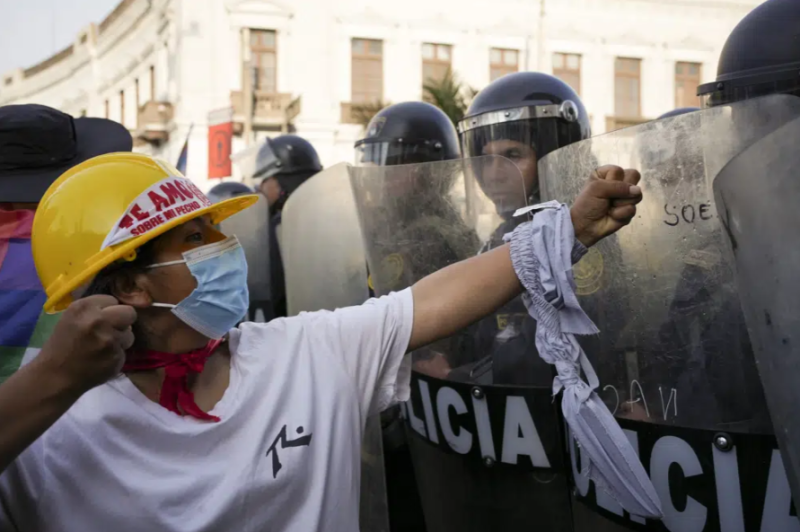In front of the hundreds of roadblocks that have been set up mainly in the southern part of the country, the ministries of interior and defense announced that “the Peruvian police, with the support of the armed forces”, will proceed “to open the roads”
Hundreds of protesters, some covered with hoods and armed with shields, clashed with heavy police forces around Peru’s parliament on Saturday, as mass protests and incidents that have claimed the lives of at least 58 people since December 7 continue.
A protester was killed in yesterday’s incidents in Lima, the Ombudsman, an independent authority responsible for the defense of human rights, announced via Twitter. This is the first death in the Peruvian capital.
With the atmosphere suffocating due to the tear gas, the center of Lima turned once again into a theater of clashes between the forces of order and the demonstrators who, according to official data, have claimed the lives of 58 civilians, among them a policeman, who was burned alive in patrol car.
The incidents surrounding the Congress broke out the day after the parliamentarians refused to give the green light to the further acceleration of the elections, to be held in 2023.
“We want dignity, Dina step down now,” chanted the protesters, addressing the interim president Dina Bolluarte, who the participants in the demonstrations demand to leave power.
Ms Bolluarte has ruled Peru since December 7, the day left-wing former President Pedro Castillo, who was accused of attempting a “coup” by announcing he was dissolving Congress as it prepared to impeach him, stood down and was arrested. This was the trigger for the protests.
The march in Lima yesterday began in a festive atmosphere, but turned into a battle between hooded men and police riot units. Apart from the man who was killed, two others were injured, among them a policeman.
First death in the capital
Until yesterday, the deaths had been recorded mainly in Puno and other Andean regions in the south of the country, home to poor and historically neglected populations who supported Mr. Castillo, whose election victory they saw as revenge for contempt and racism of the elites of the capital, especially towards the natives.
The protesters demand immediate presidential and parliamentary elections. President Boluarte tabled a proposal for a constitutional review to take place in October, but the text was rejected by Congress after midnight Friday to Saturday.
A draft law submitted earlier on Friday called for elections to be held in December. In order to appease the anger of the protesters, the Congress had a few days ago accepted the proposal of the transitional president that the elections be held early, in April 2024.
The interim president, whose term could theoretically last until 2026, is calling for elections to be held within the year so that the Latin American country can get out of the “slum”.
Yesterday he declared that Congress was not “able to agree on a date to hold general elections in which Peruvians will be able to freely and democratically elect the new authorities.”
“We urge MPs to put aside their partisan interests and put Peru’s interests first,” he added via Twitter.
From the capital’s airport, from where medicines and medical supplies were sent to the south, which has been paralyzed by the blockades, Ms. Bolovarte reiterated that she has no intention of “hooking into power.”
Ten deaths attributed to blockades
“We will not wait. They have to be done now,” erupted Sandra Sorella, a 53-year-old educator, demanding the polls be set up immediately during a demonstration in Cusco, a city deserted by tourists, who usually abound as they visit Machu Picchu. The archeological site of the Incas, the jewel of tourism in Peru, has been closed again, due to the political crisis.
In the face of hundreds of roadblocks, mainly in the southern part of the country, the Interior and Defense ministries announced on Thursday that “the Peruvian police, with the support of the armed forces”, will proceed “to open the roads”.
The government says the roadblocks have caused ten deaths, including three children who it says could not get the emergency medical care they needed.
Authorities count 88 roadblocks in eight of Peru’s 25 regions. The most important is the one through which food is transported to Lima.
The blockades cause shortages of essential goods and fuel for vehicles and household use, drive up prices and, always according to the government, complicate access to health services and the transport of medicines in parts of the country.
“There is neither gas nor fuel. In the stores you only find long-lasting food and everything is very expensive, it costs three times the normal price,” explained Guillermo Santino, an executive of a marketing company based in Ica, 300 kilometers south of Lima, on Friday.
RES-EMP
Read the News today and get the latest news.
Follow Skai.gr on Google News and be the first to know all the news.
With a wealth of experience honed over 4+ years in journalism, I bring a seasoned voice to the world of news. Currently, I work as a freelance writer and editor, always seeking new opportunities to tell compelling stories in the field of world news.











